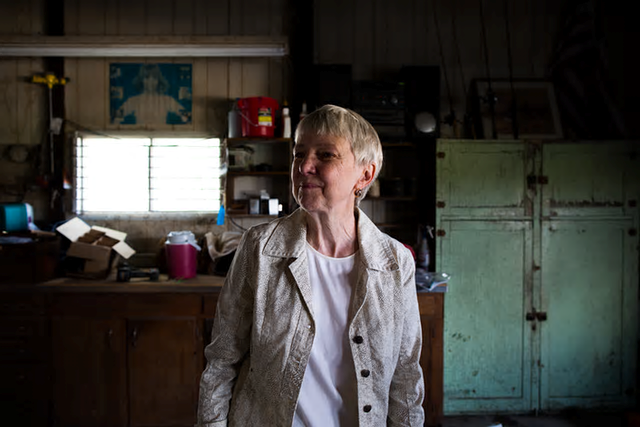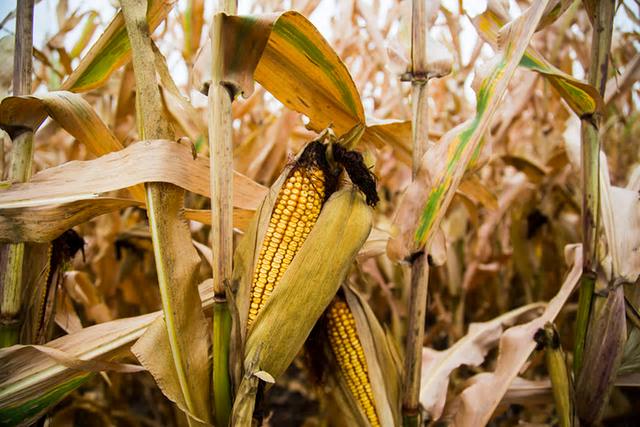The Guardian revealed the silent epidemic killing farmers in unprecedented numbers in an unusually thoughtful expose this week.
Debbie Weingarten, a former farmer, starts out her report by sharing the sad story of her interview with Ginnie Peters.
It is dark in the workshop, but what light there is streams in patches through the windows. Cobwebs coat the wrenches, the cans of spray paint and the rungs of an old wooden chair where Matt Peters used to sit. A stereo plays country music, left on by the renter who now uses the shop.
“It smells so good in here,” I say. “Like …”
“Men, working,” finishes Ginnie Peters.
We inhale. “Yes.”
Ginnie pauses at the desk where she found her husband Matt’s letter on the night he died.
“My dearest love,” it began, and continued for pages. “I have torment in my head.”

Ginnie Peters stands in the doorway of the shed where she found her husband dead
Ginnie shares that she knew her husband was stressed resulting from the pressures of keeping a farm going despite the conglomerates working to suffocate the common farmer.
On the morning of his last day, 12 May 2011, Matt stood in the kitchen of their farmhouse.
“I can’t think,” he told Ginnie. “I feel paralyzed.”
It was planting season, and stress was high. Matt worried about the weather and worked around the clock to get his crop in the ground on time. He hadn’t slept in three nights and was struggling to make decisions
Ginnie felt an “oppressive sense of dread” that intensified as the day wore on. At dinnertime, his truck was gone and Matt wasn’t answering his phone. It was dark when she found the letter. “I just knew,” Ginnie says. She called 911 immediately, but by the time the authorities located his truck, Matt had taken his life.
As the author of the report points out herself, everyday farmers can no longer earn enough to break even most years.
We were growing food, but couldn’t afford to buy it. We worked 80 hours a week, but we couldn’t afford to see a dentist, let alone a therapist. I remember panic when a late freeze threatened our crop, the constant fights about money, the way light swept across the walls on the days I could not force myself to get out of bed.
Most farms have huge debts and there are no laws in place to ensure they are paid for their labor.
In August 2017, Tom Giessel, farmer and president of the Pawnee County Kansas Farmers Union produced a short video called “Ten Things a Bushel of Wheat Won’t Buy”. At $3.27 per bushel (60lb), Giessel says, “The grain I produce and harvest is my ‘currency’ and it is less than one-fifth of what it should be priced.”
He shows snapshots of consumer goods that cost more than a bushel of wheat: six English muffins, four rolls of toilet paper, a single loaf of bread – even though one bushel of wheat is enough to make 70 one-pound breadloaves.
Dr Zidek says the wellbeing of farmers is inextricably linked to the health of rural communities. “The grain prices are low. The gas prices are high. Farmers feel the strain of ‘I’ve got to get this stuff in the field. But if I can’t sell it, I can’t pay for next year’s crop. I can’t pay my loans at the bank off. And that impacts the rest of us in a small community, because if the farmers can’t come into town to purchase from the grocery store, the hardware store, the pharmacy – then those people also struggle.”
Farmers are taking huge gambles only to have conglomerates such as Kellogg’s pay mere dollars for their crops. And the ones paying the ultimate price are the hardworking farmers working 20 hours a day. The rates of farmers committing suicide are staggering.
Last year, a study by the Centers for Disease Control and Prevention (CDC) found that people working in agriculture – including farmers, farm laborers, ranchers, fishers, and lumber harvesters – take their lives at a rate higher than any other occupation. The data suggested that the suicide rate for agricultural workers in 17 states was nearly five times higher compared with that in the general population.
And due to the rural nature of the occupation and the ambiguous nature of farming accidents the real statistics on these suicides are hard to find.
After the study was released, Newsweek reported that the suicide death rate for farmers was more than double that of military veterans. This, however, could be an underestimate, as the data collected skipped several major agricultural states, including Iowa. Rosmann and other experts add that the farmer suicide rate might be higher, because an unknown number of farmers disguise their suicides as farm accidents.
The US farmer suicide crisis echoes a much larger farmer suicide crisis happening globally: an Australian farmer dies by suicide every four days; in the UK, one farmer a week takes his or her own life; in France, one farmer dies by suicide every two days; in India, more than 270,000 farmers have died by suicide since 1995.
And what is the solution to this problem? Head on over to the next page to hear of the pioneering organization working to combat this crisis


A Trump supporter calling someone ignorant
HAHAHA
Liberals, just when you think they can’t get any dumber they go and prove you wrong.
Probably could read whole article if stupid survival technics would stop sensoring it so I can’t read it. Thanks FB. I see again you do that want us to know the truth. Leave the articles alone.
I don’t think they are killing themselves I think they are being killed…
I don’t believe this headline at all.
Yes, it in infuriating to have the stupid ad pop up so you can’t read the entire article! Done on purpose so censor? I have complained about it several times but FB doesn’t take it down.
So American can import food from China, India and rest countries
INDIAN’S from India and many other countries farmers are doing the same thing. Government regulations of requirements of genetic altered seed to get more fruiting etc. And rules and regulations on how they are extorted to use what the government programs force ,are putting them into slavery and as servants. These seeds are sterile after the first crop and these folks are at the government’s mercy if they want to survive. This is the munipulation the government forces to get control of every citizen and their lands . No self sufficient citizen in the world is valuable because they must have the heel in their backs ,submission!
Praying for our Farmers.Hard working folks.
THIS IS LIBERAL PROPAGANDA